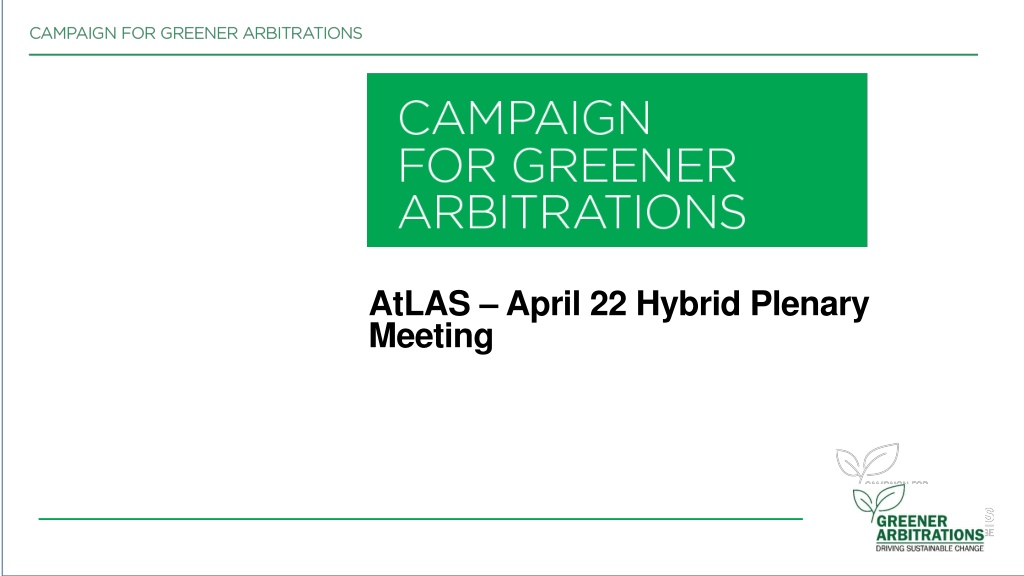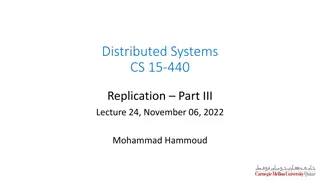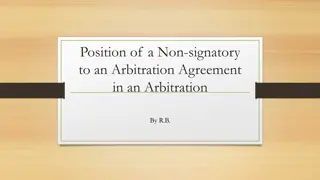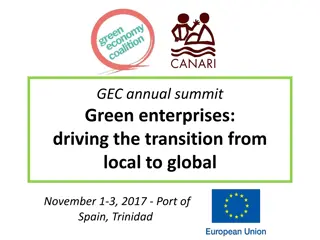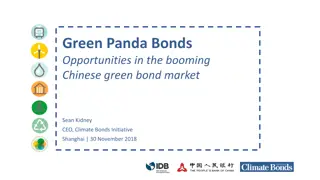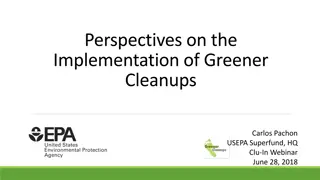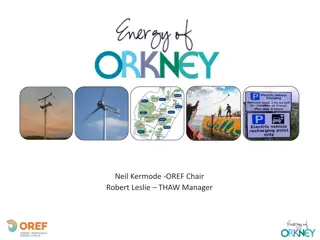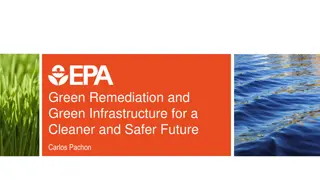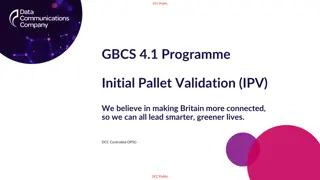Green Protocols for Greener Arbitrations
The Green Protocols introduced by AtLAS aim to guide the arbitration community in committing to environmentally sustainable practices. These protocols suggest ways to reduce carbon emissions, energy consumption, waste generation, and unnecessary travel by utilizing electronic communication, video conferencing, and clean energy sources. The Framework and Protocols, though not binding, provide practical steps towards creating a greener arbitration environment.
Download Presentation

Please find below an Image/Link to download the presentation.
The content on the website is provided AS IS for your information and personal use only. It may not be sold, licensed, or shared on other websites without obtaining consent from the author.If you encounter any issues during the download, it is possible that the publisher has removed the file from their server.
You are allowed to download the files provided on this website for personal or commercial use, subject to the condition that they are used lawfully. All files are the property of their respective owners.
The content on the website is provided AS IS for your information and personal use only. It may not be sold, licensed, or shared on other websites without obtaining consent from the author.
E N D
Presentation Transcript
AtLAS April 22 Hybrid Plenary Meeting
2019 2019 2021 2021 Founded by Lucy Greenwood Draft Framework and six Green Protocols launched in January 2020 2020 February-March regional roundtables to collate feedback Green Pledge formally launched Final Framework and Protocols released on Earth Day 2021 Steering Committee established Environmental Impact Assessment carried out Regional Committees established Awarded Best New Development by GAR 2
Introduction to the Protocols The Green Protocols provide practical ways to implement the Campaign for Greener Arbitrations Guiding Principles, which asks the arbitration community to commit to: 1. Creating a workspace with a reduced environmental footprint by looking for opportunities to reduce energy consumption and waste; 5. Using, where possible, suppliers and service providers who are committed to reducing their environmental footprint (including for the purposes of arranging an arbitration hearing); 2. Corresponding electronically, unless hard copy correspondence is expressly needed in the circumstances, while also being mindful that email has a carbon footprint; 6. Considering and/or suggesting, where appropriate, that witnesses or experts give evidence through videoconferencing facilities, rather than attend hearings in person; 3. Encouraging the use of videoconferencing facilities as an alternative to travel (including for the purposes of conducting fact finding or interviews with witnesses); 7. Avoiding unnecessary travel and using videoconferencing facilities as an alternative; 4. Avoiding printing, requesting the use of electronic rather than hard copies of documents and promoting the use of electronic bundles at hearings; 8. Considering and questioning the need to fly at all times and offsetting carbon emissions for any arbitration related travel.
Introduction to the Protocols Three Main Areas of Focus The Campaign s work indicates that by focusing on three areas, practitioners could substantially reduce carbon emissions. 1. Adopting clean forms of energy 2. Reducing use of long haul travel Reducing waste, for example by eliminating hard copy filings altogether 3.
Introduction to the Protocols 1Framework 6 Green Protocols 1Model Procedural Order Protocol Model Procedural Order Protocol Protocol Framework Protocol Protocol Protocol
Introduction to the Protocols Application of the Framework and Green Protocols The Framework and the Green Protocols are not binding and are not intended to displace applicable rules or derogate from the arbitration agreement unless and to the extent the Parties so agree (either in the arbitration agreement or subsequently) or the Tribunal so orders. The Framework and the Green Protocols do not establish liability or a liability standard for legal or regulatory purposes.
Green Protocol for Arbitral Proceedings Section I. Initial Commitment Provides Parties and arbitrators with tangible measures to implement in specific arbitral proceedings by party agreement or by Tribunal order. Section II. Conduct of Proceedings Section III. Written Submissions and Documentary Evidence Section IV. Document Production Section V. Witnesses and Experts Preparation Section VI. Hearings Section VII. Settlements Section VIII. Travel Responsibly Section IX. Offsetting Carbon Emissions
Model Green Procedural Order Environmental Purpose Section I. Provides draft language which can be easily adopted by Tribunals to implement sustainability measures in the conduct of an arbitration. Section II. Communications Section II. Conduct of Proceedings Section III. Written Submissions and Documentary Evidence Section IV. Document Production Section V. Witnesses and Experts Preparation Section VI. Hearings Section VII. Travel Section VIII. Offsetting
Green Protocol for Law Firms, Chambers and Legal Service Providers Working in Arbitration Section I. Initial Commitment Provides legal advisors and their employees with suggested sustainability measures for minimising their environmental impact which can be integrated into daily operations or adopted on a case by case basis. Section II. Use of Green Energy Section III. Reduce Energy Consumption Section IV. Electronic Operations Section V. Legal Advisor Staff Section VI. Minimise Printing and Use of Paper Section VII. Encourage Recycling Section VIII. Limit Use of Single Use Items/Eliminate Plastic Section IX. Partner with Green Organisations Section X. Travel Responsibly Section XI. Incentivisation Section XII. Social Responsibility Section XIII. Offsetting Carbon Emissions
Green Protocol for Arbitrators Provides individual arbitrators with practical guidance to minimise the environmental impact of their practice, including during the course of arbitral proceedings. Section I. Initial Commitment Section II. Minimise Printing and Use of Paper Section III. Conduct of Proceedings Section IV. Hearings Section V. Working Environment Section VI. Encourage Recycling Section VII. Offsetting Carbon Emissions
Green Protocol for Arbitral Institutions Provides arbitral institutions with practical guidance on minimising their environmental impact. Section I. Initial Commitment Section II. Use of Green Energy Section III. Reduce Energy Consumption Section IV. Minimise Printing and Use of Paper Section V. Encourage Recycling Section VI. Limit Use of Single Use Items/Eliminate Plastic Section VII. Partner with Green Organisations Section VIII. Travel Responsibly Section IX. Incentivise Staff Section X. Social Responsibility Section XI. Offsetting Carbon Emissions
Green Protocol for Arbitration Conferences Section I. Initial Commitment Suggests measures which can be adopted to reduce the environmental impact of arbitration conferences. Section II. Venue Selection Section III. Event Planning Section IV. Conference Registration and Materials Section V. Conference Procedures Section VI. Use of Green Energy Section VII. Reduce Energy Consumption Section VIII. Minimise Printing and Use of Paper Section IX. Encourage Recycling Section X. Limit Use of Single Use Items/Eliminate Plastic Section XI. Partner with Green Organisations Section XII. Travel Responsibly Section XIII. Post-Conference Section XIV. Offsetting Carbon Emissions
Green Protocol for Arbitration Hearing Venues Section I. Initial Commitment Provides arbitration facilities and hearing centres with measures to minimise their environmental impact as regards their daily operating procedures or as related to a particular arbitration. Section II. Use of Green Energy Section III. Reduce Energy Consumption Section IV. Conduct of Proceedings Section V. Minimise Printing and Use of Paper Section VI. Encourage Recycling Section VI. Limit Use of Single Use Items/Eliminate Plastic Section VII. Partner with Green Organisations Section VIII. Travel Responsibly Section X. Offsetting Carbon Emissions
Closing Remarks We must shift our thinking away from short-term gain toward long-term investment and sustainability, and always have the next generations in mind with every decision we make. -Deb Haaland, US Representative (D-N.M.), Pending nominee for US Secretary of Interior
